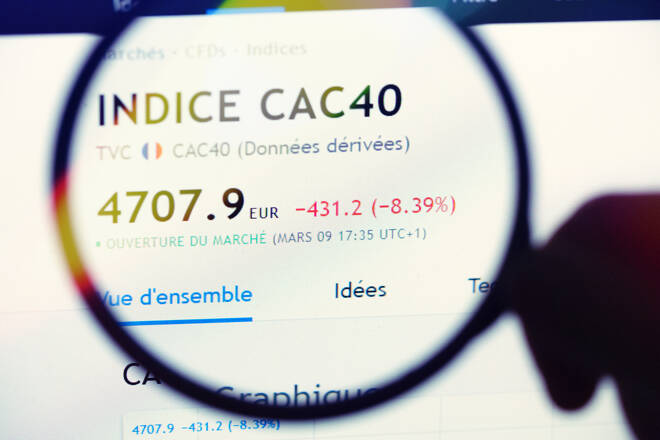Advertisement
Advertisement
European Equities German Factory Orders and COVID-19 News in Focus
By:
Following a bearish end to last week, German factory orders will be in focus later this morning. While we can expect influence, COVID-19 news updates and sentiment towards inflation and monetary policy will remain key.
Economic Calendar
Monday, 6th December
German Factory Orders (MoM) (Oct)
German IHS Markit Construction PMI (Nov)
Tuesday, 7th December
German Industrial Production (MoM) (Oct)
German ZEW Current Conditions (Dec)
German ZEW Economic Sentiment (Dec)
Eurozone GDP (QoQ) (Q3)
Eurozone GDP (YoY) (Q3)
Eurozone ZEW Economic Sentiment (Dec)
Wednesday, 8th December
French Non-Farm Payrolls (QoQ) (Q3)
Thursday, 9th December
German Trade Balance (Oct)
Friday, 10th December
German CPI (MoM) (Nov) Final
The Majors
It was a bearish end to the week for the European majors on Friday.
The DAX30 and EuroStoxx600 fell by 0.61% and by 0.57% respectively, with the CAC40 ending the day down by 0.44%.
In spite of relatively upbeat economic data from the Eurozone, the majors struggled amidst market concerns over the Omicron strain. Uncertainty over vaccine efficacy and whether symptoms will be more severe than other strains weighed on risk sentiment.
Later in the session, disappointing NFP numbers from the U.S added to the market angst on the day.
The Stats
It was a busy Eurozone economic calendar. Member state and Eurozone private sector PMIs and Eurozone retail sales were in focus.
Member States
For Spain, the services PMI rose from 56.6 to 59.8 versus a forecasted 58.8.
Service sector activity in Italy also improved, with the PMI up from 52.4 to 55.9. Economists had forecast a rise to 54.8.
For France, the services PMI rose from 56.6 to 57.4, which was down from a prelim 58.2.
Germany’s services PMI increased from 52.4 to 52.7 which was down from a prelim 53.4.
The Eurozone
For the Eurozone, the services PMI increased from 54.6 to 55.9, which was down from a prelim 56.6.
As a result, the Composite PMI rose from 54.2 to 55.4, which was down from a prelim 55.8.
According to the November survey,
- In spite of the pickup in private sector activity, service sector growth masked the second-softest increase in manufacturing production since its recovery began in Jul-2020.
- New business continued to rise in November, though the rate of increase was the weakest since April. Significantly, a downward trend continued since July.
- Job growth accelerated across the private sector, as firms looked to boost capacities and address rising backlogs.
- Price pressures remained widespread, however. Both input costs and output charge inflation reached new survey highs.
- Business confidence weakened to a 10-month low, the declined attributed to service providers.
By Country
- Ireland registered the largest rate of expansion, with a 7-month low composite PMI of 59.3.
- Germany ranked at the bottom of the table, with a 2-month high composite PMI of 52.2.
Retail Sales
For the euro area, retail sales rose by 0.2% in October, after having fallen by 0.4%% in September. Economists had forecast a 0.2% rise.
According to Eurostat,
- Sales of automotive fuels increased by 1.3% and by 0.4% for non-food products.
- Food, drinks, & tobacco sales fell by 0.1%.
- Slovenia (+13.0%) and Portugal (+2.3%) recorded the largest increases in sales.
- Latvia (-5.4%), Austria (-2.8%), and Estonia (-2.6%) recorded the largest decreases compared with Sep-2021.
- Compared with October 2020, retail sales rose by 1.4%.
- Automotive fuel sales increased by 8.5%, and nonfood products by 2.5%. Food, drinks, & tobacco sales fell by 1.2%, however.
From the U.S
Nonfarm payrolls and service sector PMI numbers delivered mixed results for the markets.
In November, nonfarm payrolls increased by just 210k following a 546k increase in October. While the participation rate rose from 61.6% to 61.8%, however, the unemployment rate fell from 4.6% to 4.2%.
For the services sector, the ISM Non-Manufacturing PMI rose from 66.7 to 69.1, which was market positive.
The Market Movers
For the DAX: It was a bearish day for the auto sector on Friday. Continental led the way down once more, sliding by 3.98%, with BMW ending the day down by 1.28%. Daimler and Volkswagen fell by 1.11% and by 1.06% respectively
It was also a bearish day for the banks. Deutsche Bank slid by 1.92%, with Commerzbank falling by 0.30%.
From the CAC, it was a relatively bearish day for the banks. Soc Gen and BNP Paribas saw losses of 0.53% and 0.50% respectively, with Credit Agricole falling by 0.41%.
The French auto sector also had a bearish session. Stellantis NV and Renault ended the day down by 1.16% and by 1.10% respectively.
Air France-KLM slipped by 0.61%, with Airbus SE sliding by 2.52%.
On the VIX Index
It was a back into the green for the VIX on Friday.
Partially reversing a 10.19% fall from Thursday, the VIX rose by 9.73% to end the day at 30.67.
The NASDAQ slid by 1.92%, with the Dow and the S&P500 seeing losses of 0.17% and 0.84% respectively.
The Day Ahead
It’s a relatively busy day ahead on the Eurozone’s economic calendar. German factory orders and construction PMI numbers are due out early in the European session.
Expect factory orders to be key.
With no major stats from the U.S to consider later in the day, however, expect central bank chatter and COVID-19 news updates to be key.
The Futures
In the futures markets, at the time of writing, the Dow Mini was up by 59 points.
For a look at all of today’s economic events, check out our economic calendar.
About the Author
Bob Masonauthor
With over 28 years of experience in the financial industry, Bob has worked with various global rating agencies and multinational banks. Currently he is covering currencies, commodities, alternative asset classes and global equities, focusing mostly on European and Asian markets.
Advertisement
